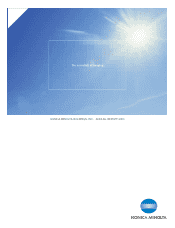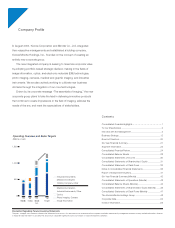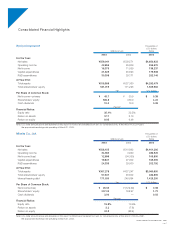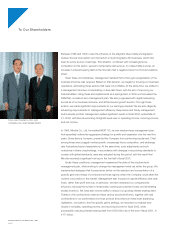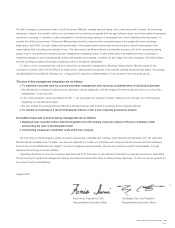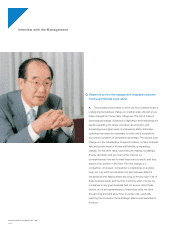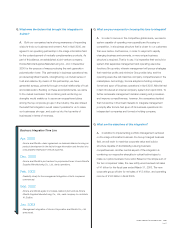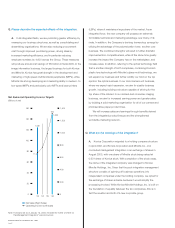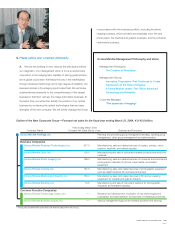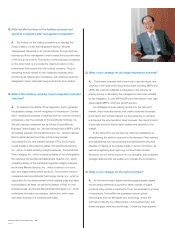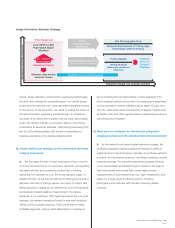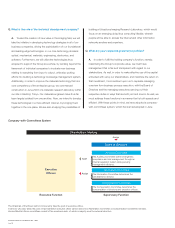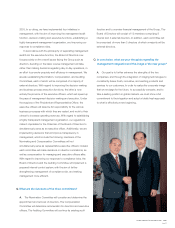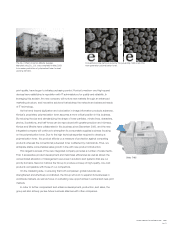Konica Minolta 2003 Annual Report Download - page 7
Download and view the complete annual report
Please find page 7 of the 2003 Konica Minolta annual report below. You can navigate through the pages in the report by either clicking on the pages listed below, or by using the keyword search tool below to find specific information within the annual report.
KONICA M INOLTA HOLDINGS, INC. 2 0 0 3
Pag e 5
Business Integration Time Line
Apr. 2000
Konica and Minolta—basic agreement on business alliance focusing on
product development in the field of image information and the start of a
consumables-related joint-venture business.
Dec. 2000
Konica and Minolta’s joint venture for polymerized toner, Konica Minolta
Supplies Manufacturing Co., Ltd., starts operations.
Feb. 2002
Feasibility study for the management integration of both companies
commenced.
Sep. 2002
Konica and Minolta agree to increase capital of joint-venture Konica
Minolta Supplies Manufacturing Co., Ltd., each company to contribute
¥1.3 billion.
Jan. 2003
Management integration of Konica Corporation and Minolta Co., Ltd.
announced.
Q. What were the factors that brought this integration to
fruition?
A. Both our companies had a strong awareness of impending
crisis vis-a`-vis our business environment. And in April 2000, we
agreed to an operating partnership in the image information field
for the codevelopment of mutually complementary products. As
part of this alliance, we established a joint-venture company,
Konica Minolta Supplies Manufacturing Co., Ltd. in December
2000 for the purpose of mass-producing the next-generation
polymerization toner. This partnership in business operations has
produced significant results, strengthening our mutual sense of
trust and reliance. By means of this partnership, we have
generated synergy, primarily through a mutual relationship of trust
and collaboration. Building on these accomplishments, we came
to the mutual conclusion that combining and reinforcing our
strengths would enable us to secure an unquestioned place
among the top corporate groups in the industry. We also shared
the belief that integration would make it possible for us to make
our businesses stronger, and push us into the top ranks of
businesses in terms of revenues.
Q. What are your reasons for choosing this time to integrate?
A. In order to survive in the competitive global arena, we need a
system capable of operating more speedily and focusing on
competition, in a business structure that is closer to our customers
than ever before. Furthermore, in order to respond to rapidly
changing business environments, a more unique business
structure is required. That is to say, it is imperative that we build a
system that separates management and operating executive
functions Group-wide, wherein management will pursue strategies
that maximize profits and minimize Group-wide risks, and the
operating executive will maximize company competitiveness in the
marketplace. Accordingly, Konica adopted a holding company
format and spun off business operations in April 2003. Minolta had
in fact introduced an internal company system from April 2002. To
further accelerate management decision-making and processes,
and improve competitiveness, however, the companies decided
that it would be in their best interests to integrate management
promptly after Konica had spun off its business operations into
independent companies and formed a holding company.
Q. What are the objectives of this integration?
A. In addition to implementing portfolio management centered
on the image information business, the Group’s largest business
field, we will work to maximize corporate value and build a
structure capable of dramatically pursuing business
competitiveness. Another central aspect of the integration is
combining our respective strengths in optical technologies to
make our optics business more solid. Based on the simple sum of
the two companies’ sales, the new entity would exceed net sales
of ¥1 trillion for the fiscal year ended March 31, 2003. The new
corporate group will aim for net sales of ¥1.3 trillion, and operating
income of ¥150 billion in fiscal 2005.

